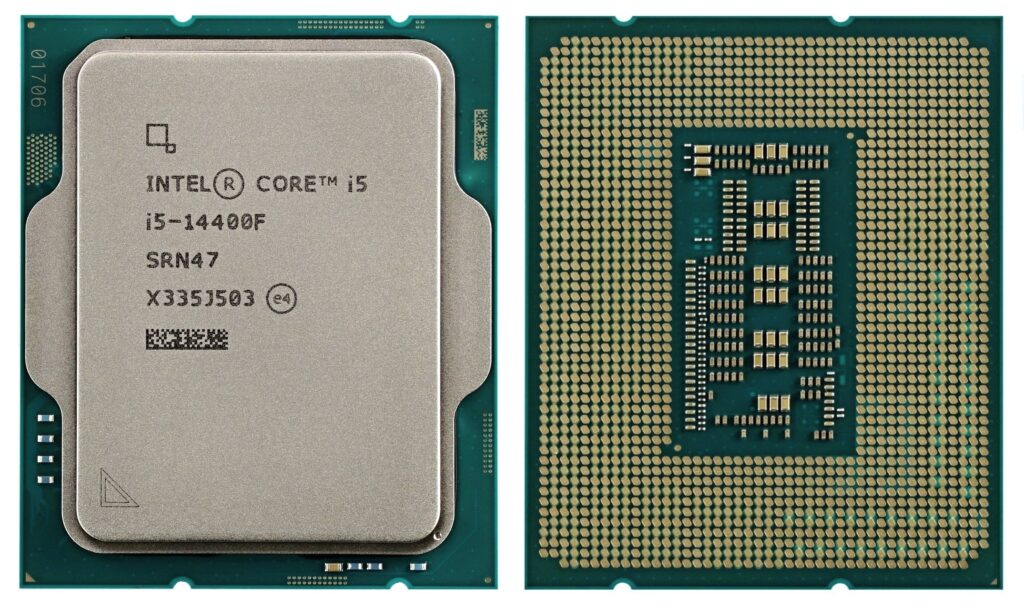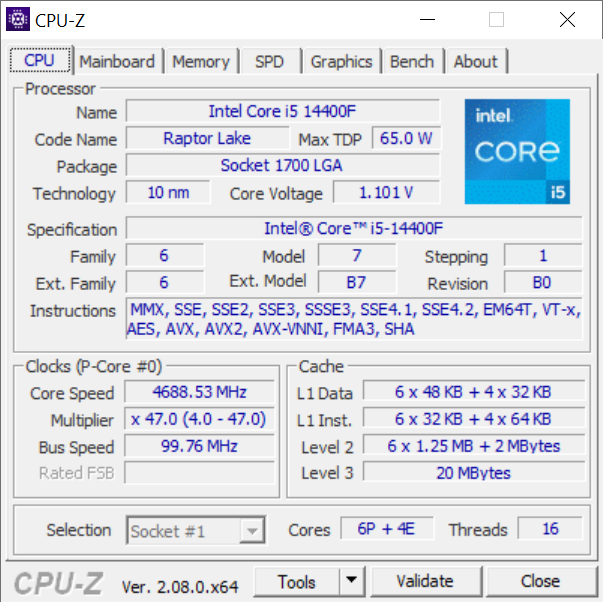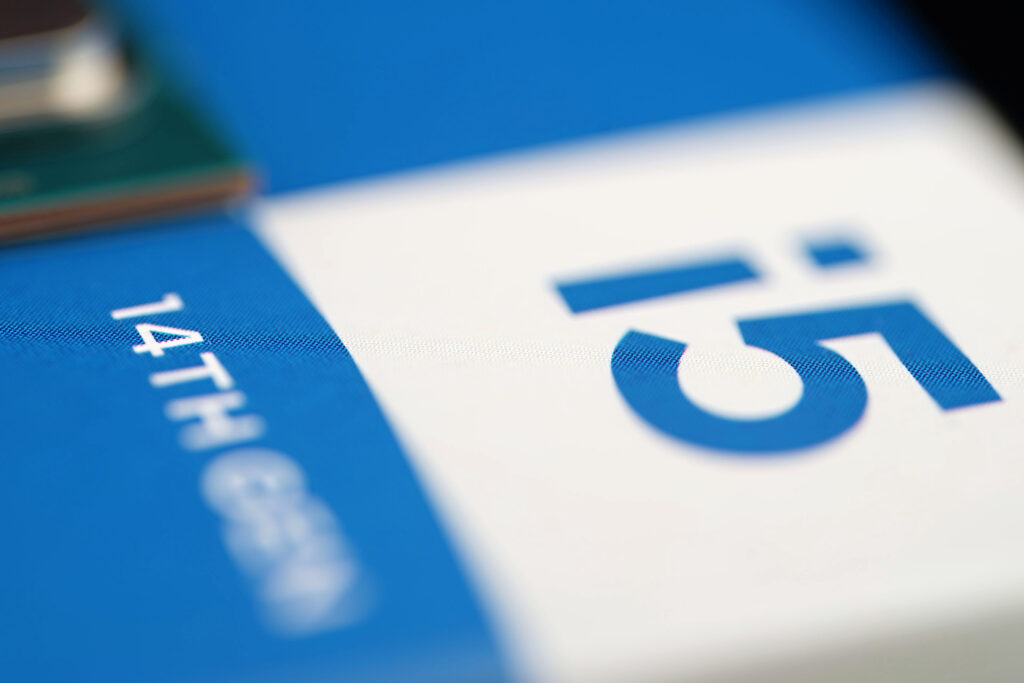Intel Core i5-14400F in detail
Also on the list of lower-power Intel Raptor Lake Refresh processors with 65W TDP is the Core i5-14400F. That is, a model that, mainly because of its attractive price-performance ratio, often ends up in lower-budget PC builds. In the 14th generation, Intel sped up the single-core boost and also E cores. And there are more changes in the small details. For example, the fact that different steppings built on different silicon are again common in e-stores.
Intel Core i5-14400F in detail
From the specifications, it is clear that the processors from the lowest “400” series in the Raptor Lake Refresh generation, compared to the older Raptor Lake ones (Core i5-13400/F), bring higher clock speeds. The performance should be +100 MHz for single-threaded tasks (single-core boost is listed at 4.7 GHz), and the all-core boost of E cores has also increased, to 3.5 GHz (from 3.3 GHz). The core composition has remained the same, with the Core i5-14400(F) having six P cores with HyperThreading support (i.e., two threads per core) and four E cores.
It is thus a 10-core, 16-thread processor designed for the Intel LGA 1700 platform. The 14th generation Intel Core is also probably the last one to have a dual memory controller, where DDR4 memory is supported in addition to DDR5 memory. Arrow Lake built one the LGA 1851 platform will apparently, like AMD’s Ryzen 7000, only support the DDR5 standard.
So there is still an opportunity to use some “old” memory in a new configuration or to save some money when buying new memory. The price of DDR5 modules is still quite higher per gigabyte compared to DDR4 modules, which naturally translates into the overall price/performance ratio in the low-end segment.
The model with the “F” at the end (Core i5-14400F) has, traditionally, a disabled graphics core (Intel UHD 730 with 24 EUs), which is functional in the Core i5-14400. The maximum power limit (PL2) has not changed between generations and is still 148W. At higher clock speeds, this suggests that there might be a small improvement in the efficiency of the Intel 7 Ultra manufacturing node. Unless, of course, the Core i5-14400F will in practice draw more power than the Core i5-13400F.
Two steppings, both as “box”
It is also important to know that there are again Core i5-14400(F) versions with different silicon chips. One (stepping B0) has eight P cores and sixteen E cores in a die area of approximately 257 mm². Then there’s the second variant with a slightly smaller chip (~209 mm²) from the Alder Lake generation, with both eight P and E cores.
It’s actually the same situation as last time, with the Core i5-13400(F) processors. The difference is that this time both B0 (Raptor Lake) and C0 (Alder Lake) steppings are retailing in “box” packages (i.e. in a box with a Intel Laminar RM1 cooler). The easiest way to tell which is which is by looking at the S-spec codes, which are different. It’s SRN47 (B0/Raptor Lake) and SRN3R (C0/Alder Lake). These are printed on the IHS and also on the label with EAN codes.
We have the stepping B0 in the tests. The measured Core i5-13400F is stepping C0. Take this into account when comparing results. If you were wondering what the differences across steppings might be, we’ve covered that with the Core i5-13400F. And even more in detail in terms of gaming performance impact.
Analysis of the Core i5-14400F (stepping B0 vs C0) is coming soon. Now, it will be even more important than before, because while the Raptor Lake Core i5-13400(F) stepping B0s were only “tray”, both the B0 and C0 Core i5-14400(F)s are “box”. So unless you are purposely ordering the processor according to the S-spec code, it will be a lottery like with the Core i5-12400(F) and you can get any one of them. The fact that there are now Core i5s (not only 14400/F, but also other models) in the stepping B0 in circulation in greater numbers than there used to be is probably also related to the wafers designed primarily for Alder Lake processors running out.
| Manufacturer | Intel | Intel | AMD | |
| Line | Core i5 | Core i5 | Ryzen 5 | |
| SKU | 14400F | 13400F | 7600 | |
| Codename | Raptor Lake Refresh | Raptor Lake | Raphael | |
| CPU microarchitecture | Golden Cove (P) + Gracemont (E) | Golden Cove (P) + Gracemont (E) | Zen 4 | |
| Manufacturing node | 7 nm | 7 nm | 5 nm + 6 nm | |
| Socket | LGA 1700 | LGA 1700 | AM5 | |
| Launch date | 01/08/2024 | 01/03/2023 | 01/10/2023 | |
| Launch price | 196 USD | 196 USD | 229 USD | |
| Core count | 6+4 | 6+4 | 6 | |
| Thread count | 16 | 16 | 12 | |
| Base frequency | 2.5 GHz (P)/1.8 GHz (E) | 2.5 GHz (P)/1.8 GHz (E) | 3.8 GHz | |
| Max. Boost (1 core) | 4.7 GHz (P)/3.5 GHz (E) | 4.6 GHz (P)/3.3 GHz (E) | 5.1 GHz (unofficially 5,16 GHz) | |
| Max. boost (all-core) | 4.1 GHz | 4.1 GHz | N/A | |
| Typ boostu | TB 2.0 | TB 2.0 | PB 2.0 | |
| L1i cache | 32 kB/core (P)/64 kB/core (E) | 32 kB/core (P)/64 kB/core (E) | 32 kB/core | |
| L1d cache | 48 kB/core (P)/32 kB/core | 48 kB/core (P)/32 kB/core | 32 kB/core | |
| L2 cache | 1,25 MB/core (P)/ 2×2 MB/4 cores (E) | 1,25 MB/jadro (P)/ 2×2 MB/4 cores (E) | 1 MB/core | |
| L3 cache | 1× 20 MB | 1× 20 MB | 1× 32 MB | |
| TDP | 65 W | 65 W | 65 W | |
| Max. power draw during boost | 148 W (PL2) | 148 W (PL2) | 88 W (PPT) | |
| Overclocking support | No | No | Yes | |
| Memory (RAM) support | DDR5-4800/DDR4-3200 | DDR5-4800/DDR4-3200 | DDR5-5200 | |
| Memory channel count | 2× 64 bitov | 2× 64 bit | 2× 64 bit | |
| RAM bandwidth | 76,8 GB/s/51,2 GB/s | 76.8 GB/s/51.2 GB/s | 83,2 GB/s | |
| ECC RAM support | No | No | Yes (depends on motherboard support) | |
| PCI Express support | 5.0/4.0 | 5.0/4.0 | 5.0 | |
| PCI Express lanes | ×16 (5.0) + ×4 (4.0) | ×16 (5.0) + ×4 (4.0) | ×16 + ×4 + ×4 | |
| Chipset downlink | DMI 4.0 ×8 | DMI 4.0 ×8 | PCIe 4.0 ×4 | |
| Chipset downlink bandwidth | 16.0 GB/s duplex | 16.0 GB/s duplex | 8,0 GB/s duplex | |
| BCLK | 100 MHz | 100 MHz | 100 MHz | |
| Die size | ~209 or ~257 mm² (depending on variant) | ~209 or ~257 mm² (depending on variant) | 66,3 mm² + 118 mm² | |
| Transistor count | ? bn. | ? bn. | 6,57 + 3,37 bn. | |
| TIM used under IHS | Solder | Solder | Solder | |
| Boxed cooler in package | Intel Laminar RM1 | Intel Laminar RM1 | Wraith Stealth | |
| Instruction set extensions | SSE4.2, AVX2, FMA, SHA, VNNI (256-bit), GNA 3.0, VAES (256-bit), vPro | SSE4.2, AVX2, FMA, SHA, VNNI (256-bit), GNA 3.0, VAES (256-bit), vPro | SSE4.2, AVX2, FMA, SHA, VAES (256-bit), AVX-512, VNNI | |
| Virtualization | VT-x, VT-d, EPT | VT-x, VT-d, EPT | AMD-V, IOMMU, NPT | |
| Integrated GPU | N/A | N/A | AMD Radeon | |
| GPU architecture | – | – | RDNA 2 | |
| GPU: shader count | – | – | 128 | |
| GPU: TMU count | – | – | 8 | |
| GPU: ROP count | – | – | 4 | |
| GPU frequency | – | – | 400–2200 MHz | |
| Display outputs | – | – | DP 2.0, HDMI 2.1 | |
| Max. resolution | – | – | 3840 × 2160 px (60 Hz) | |
| HW video encode | – | – | HEVC, VP9 | |
| HW video decode | – | – | AV1, HEVC, VP9 |
- Contents
- Intel Core i5-14400F in detail
- Methodology: performance tests
- Methodology: how we measure power draw
- Methodology: temperature and clock speed tests
- Test setup
- 3DMark
- Assassin’s Creed: Valhalla
- Borderlands 3
- Counter-Strike: GO
- Cyberpunk 2077
- DOOM Eternal
- F1 2020
- Metro Exodus
- Microsoft Flight Simulator
- Shadow of the Tomb Raider
- Total War Saga: Troy
- Overall gaming performance
- Gaming performance per euro
- PCMark and Geekbench
- Web performance
- 3D rendering: Cinebench, Blender, ...
- Video 1/2: Adobe Premiere Pro
- Video 2/2: DaVinci Resolve Studio
- Graphics effects: Adobe After Effects
- Video encoding
- Audio encoding
- Broadcasting (OBS and Xsplit)
- Photos 1/2: Adobe Photoshop and Lightroom
- Photos 2/2: Affinity Photo, Topaz Labs AI Apps, ZPS X, ...
- (De)compression
- (De)encryption
- Numerical computing
- Simulations
- Memory and cache tests
- Processor power draw curve
- Average processor power draw
- Performance per watt
- Achieved CPU clock speed
- CPU temperature
- Conclusion











